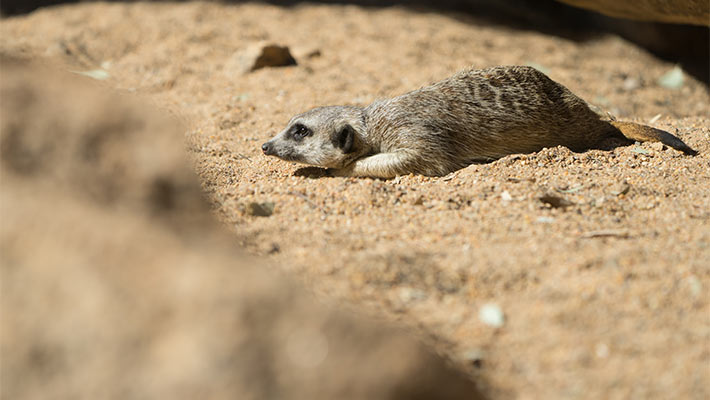Clever coat
The coat is greyish brown to light grey with dark bands across the body and dark eyes and nose. The black fur around their eyes acts like ‘built in sunglasses’ to help the meerkats to see in the bright sunlight – they can look directly into the sun to see a predatory bird.
The belly has an area of exposed skin, that can be used to absorb heat while the meerkat stands up, or lies on its back ‘sun baking’ (as our Taronga meerkats love to do!)
Digging deeper
The Meerkat’s long claws are especially adapted to scratching and digging while its pointed snout enables it to reach into small crevices.
Their burrow system is extensive and complex. They dig their burrows in hard and stony soil and they can go as deep as two metres below the surface. When digging their ears close and a special membrane covers their eyes to protect them from dirt and sand.
Meerkat groups utilize several different burrows and move from one to another. Each burrow is an extensive tunnel-and-room chamber system that remains cool even under the boiling African sun. In their habitat daily temperature can vary between as much as 43°c in summer and 18°c in winter, but in the burrows the temperature can be as little as 1°c.
On the lookout
While the majority of the group are out looking for food, individuals called sentries will stand guard on their hind legs, watching for predators such as African wildcat, cobras or jackals. They must also watch the skies for birds of prey, such as hawks and eagles, which can snatch them from the ground.
Meerkats communicate using a wide range of calls and the sentries can quickly warn the rest of the group about any approaching danger. A sharp, shrill call is the signal for all to take cover.
Family life
Slender-tailed Meerkats live in an extended family group of up to 30 individuals. A dominant pair leads the family and monopolises breeding, producing around 80% of the litter. Subordinate females help to raise the young of the dominant female. Fathers and siblings also help to raise the young, teaching them to play and forage. Other adult Meerkats will also remain behind to care for the young, allowing the mothers to feed.
As the young grow each one has an adult mentor who will teach it survival skills such as how to disarm a scorpion by biting off its stinging tail.
Standing your ground
In defensive threats and mobbing, an individual will arch its back, standing as tall as possible on all four legs, with hair and tail erect, and its head lowered. At the same time it will rock back and forth, hiss, and spit in an attempt to intimidate its enemy. Predators include Birds of prey and wild African dogs (e.g Jackals).
They might look small and cute but Meerkats have the ability to kill a cobra. Meerkats will come together and form a mob to relentlessly attack the snake if it tries to enter their burrow. They are also immune to many venomous animals such as snakes, millipedes and even scorpions, which is one of their favourite foods.

Come and meet us
You can meet our Meerkat troupe at Taronga Zoo Sydney and Taronga Western Plains Zoo Dubbo.